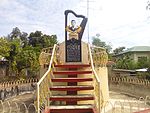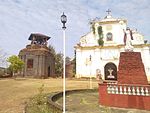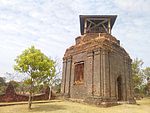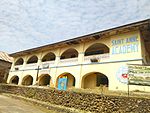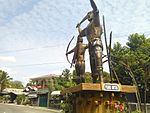Piddig | |
|---|---|
| Municipality of Piddig | |
 View of the Saint Anne Parish Church from the church patio | |
 Map of Ilocos Norte with Piddig highlighted | |
OpenStreetMap  | |
Location within the Philippines | |
| Coordinates: 18°10′N 120°44′E / 18.17°N 120.73°E | |
| Country | |
| Region | Ilocos Region (Region I) |
| Province | Ilocos Norte |
| District | 1st District |
| Barangays | 23 (see Barangays) |
| Government | |
| • Type | Sangguniang Bayan |
| • Mayor | Eduardo Eddie G. Guillen |
| • Vice Mayor | Edwin Salazar |
| • Representative | Ria Christina G. Fariñas |
| • Electorate | 14,594 voters (2019) |
| Area | |
| • Total | 216.20 km2 (83.48 sq mi) |
| Elevation | 183 m (600 ft) |
| Population (2015 census) [3] | |
| • Total | 21,497 |
| • Density | 99/km2 (260/sq mi) |
| • Households | 4,866 |
| Economy | |
| • Income class | 3rd municipal income class |
| • Poverty incidence | 11.37% (2015)[4] |
| • Revenue | ₱120,518,691.72 (2016) |
| Time zone | UTC+8 (PST) |
| ZIP code | 2912 |
| PSGC | |
| IDD : area code | +63 (0)77 |
| Climate type | tropical monsoon climate |
| Native languages | Ilocano Tagalog |
| Website | www |
Piddig, officially the Municipality of Piddig (Ilocano: Ili ti Piddig; Filipino: Bayan ng Piddig) is a 3rd class municipality in the province of Ilocos Norte, Philippines. According to the 2015 census, it has a population of 21,497 people. [3]
The town is known for its role in the Basi Revolt, led by Pedro Mateo, a native of Piddig. Today, Piddig is known for its basi and for their sariwagwag, a dish made out of gabi leaves with fresh shrimps that are freshly gathered from their rich river. The municipio (town hall) is located on top of a hill offering panoramic views of fields and mountains.
Piddig is the birthplace of Teófilo Yldefonso, a Filipino swimmer who is the first Filipino to win an Olympic medal, and the only Filipino to win multiple medals.
Geography
Piddig's terrain is hilly with rice plains interspersed in between. It sits at a higher elevation than most of the towns in Ilocos Norte. It is a great place for a day hike, if one does not mind traversing through rivers, forests, and fields.
Barangays
Piddig is politically subdivided into 23 barangays. [2]
- Ab-abut
- Abucay
- Anao (Poblacion)
- Arua-ay
- Bimmanga
- Boyboy
- Cabaroan (Poblacion)
- Calambeg
- Calluza
- Dupitac
- Estancia
- Gayamat
- Lagandit
- Libnaoan
- Loing (Poblacion)
- Maab-abaca
- Mangitayag
- Maruaya
- San Antonio
- Santa Maria
- Sucsuquen
- Tangaoan
- Tonoton
Climate
| Climate data for Piddig, Ilocos Norte | |||||||||||||
|---|---|---|---|---|---|---|---|---|---|---|---|---|---|
| Month | Jan | Feb | Mar | Apr | May | Jun | Jul | Aug | Sep | Oct | Nov | Dec | Year |
| Average high °C (°F) | 27 (81) | 28 (82) | 30 (86) | 32 (90) | 31 (88) | 31 (88) | 30 (86) | 30 (86) | 30 (86) | 29 (84) | 28 (82) | 27 (81) | 29 (85) |
| Average low °C (°F) | 20 (68) | 20 (68) | 21 (70) | 23 (73) | 25 (77) | 25 (77) | 25 (77) | 25 (77) | 24 (75) | 23 (73) | 22 (72) | 21 (70) | 23 (73) |
| Average precipitation mm (inches) | 38 (1.5) | 37 (1.5) | 37 (1.5) | 49 (1.9) | 181 (7.1) | 214 (8.4) | 264 (10.4) | 251 (9.9) | 243 (9.6) | 229 (9.0) | 129 (5.1) | 96 (3.8) | 1,768 (69.7) |
| Average rainy days | 11.6 | 10.7 | 12.4 | 15.2 | 22.6 | 25.0 | 26.1 | 24.9 | 24.3 | 19.2 | 16.4 | 15.4 | 223.8 |
| Source: Meteoblue [5] | |||||||||||||
Demographics
|
| ||||||||||||||||||||||||||||||||||||||||||||||||
| Source: Philippine Statistics Authority [3] [6] [7][8] | |||||||||||||||||||||||||||||||||||||||||||||||||
In the 2015 census, the population of Piddig was 21,497 people, [3] with a density of 99 inhabitants per square kilometre or 260 inhabitants per square mile.
List of Cultural Properties in Piddig
| Cultural Property wmph identifier | Site name | Description | Province | City/municipality | Address | Coordinates | Image |
|---|---|---|---|---|---|---|---|
| Don Claro Caluya Monument | Ilocos Norte | Piddig | Estella Street | 18°09′58″N 120°42′56″E / 18.166165°N 120.715461°E | |||
| Rizal Monument | Ilocos Norte | Piddig | Piddig Municipal Grounds, Estella Street | 18°09′59″N 120°42′54″E / 18.166350°N 120.714976°E | |||
| Raquiza House | Ilocos Norte | Piddig | Barangay Cabaroan | 18°10′01″N 120°42′55″E / 18.166878°N 120.715381°E |  | ||
| Teodoro Pacairo House | Ilocos Norte | Piddig | #004 Barangay Cabaroan | 18°10′00″N 120°42′56″E / 18.166677°N 120.715575°E |  | ||
| Santa Ana Church | Ilocos Norte | Piddig | Poblacion | 18°09′58″N 120°43′00″E / 18.166240°N 120.716648°E | |||
| Bell tower of Santa Ana Church | Ilocos Norte | Piddig | Poblacion | 18°09′58″N 120°42′59″E / 18.166144°N 120.716395°E | |||
| Saint Anne Academy | Ilocos Norte | Piddig | Poblacion | 18°09′57″N 120°43′01″E / 18.165898°N 120.716915°E | |||
| Basi Revolt Monument | Ilocos Norte | Piddig | Poblacion | 18°09′50″N 120°42′52″E / 18.163759°N 120.714569°E |
Education
Almost each barrio or barangay in Piddig has its own elementary school. The town's poblacion Anao, historically had two, Piddig Central (North) and South Piddig Central elementary schools. Both schools are situated next to each other north of town. The schools' rivalry is legendary. In the late 1980s the schools merged as one, Piddig Central.
There are three high schools in Piddig: Piddig National High School, Roosevelt High School, and St. Anne Academy (Catholic). However, many students attend high schools in nearby Laoag City.
References
- ^ Municipality of Piddig | (DILG)
- ^ a b "Province: Ilocos Norte". PSGC Interactive. Quezon City, Philippines: Philippine Statistics Authority. Retrieved 12 November 2016.
- ^ a b c d Census of Population (2015). "Region I (Ilocos Region)". Total Population by Province, City, Municipality and Barangay. PSA. Retrieved 20 June 2016.
- ^ "PSA releases the 2015 Municipal and City Level Poverty Estimates". Quezon City, Philippines. Retrieved 1 January 2020.
- ^ "Piddig: Average Temperatures and Rainfall". Meteoblue. Retrieved 4 March 2020.
- ^ Census of Population and Housing (2010). "Region I (Ilocos Region)". Total Population by Province, City, Municipality and Barangay. NSO. Retrieved 29 June 2016.
- ^ Censuses of Population (1903–2007). "Region I (Ilocos Region)". Table 1. Population Enumerated in Various Censuses by Province/Highly Urbanized City: 1903 to 2007. NSO.
- ^ "Province of Ilocos Norte". Municipality Population Data. Local Water Utilities Administration Research Division. Retrieved 17 December 2016.

.svg.gif)
